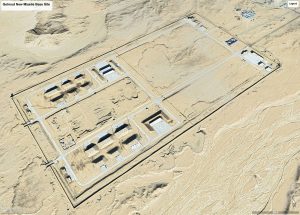Satellite imagery of new installations near Golmud city in Qinghai Province, supported by open-source analysis, points to a growing footprint of China’s Rocket Force in the area.
Since the 2021 discovery of China’s missile silo field in Gansu, the world has been paying close attention to the People’s Liberation Army Rocket Force (PLARF) posture in western China. The discovery of missile silo fields in Yumen, Hami, and Jilantai were widely seen by analysts as a rapid expansion of China’s deterrent posture.
In 2024, the Pentagon assessed that China will build up to 1,000 nuclear weapons by 2030, while Beijing is working to develop new types of missiles to deliver those warheads. In its military parade on September 3, China displayed its arsenal of intercontinental ballistic missiles, including the new silo-based DF-31BJ and the new DF-61.
Now, an open-source analysis of new structures near the city of Golmud has revealed yet another expansion of the PLARF. Golmud, located in Qinghai Province on the high Qinghai-Tibet Plateau, has long been a strategic military logistics hub.
The expansion of facilities that appear to be launch and storage sites for long-range missiles suggests Golmud is fast emerging as a new staging ground for China’s regional deterrence model. This expansion appears aimed at deterring regional threats, including Taiwan and India.
A New Brigade Takes Shape
Satellite imagery and open-source data indicate that a PLARF unit is undertaking extensive expansion near Golmud (approx. 36°13′35″N, 94°42′41″E and 36°21′36″N, 94°16′01″E). The site is likely associated with a brigade under PLARF Base 64, headquartered in Lanzhou, which oversees missile operations across northwestern China.
Analysts suggest that the facilities under construction could be upgraded to form a new missile brigade under Base 64. Independent assessments of Chinese government sources and commercial satellite imagery point to sustained infrastructure development in the Golmud area, including missile launch sites and support buildings.
Two officials from an Asian country confirmed to The Diplomat that the new installations are linked to the PLARF’s force expansion – likely the establishment of a new missile brigade. The officials expressed concern that the development enhances China’s regional deterrence posture, particularly vis-à-vis India and Taiwan.
Activity linked to the 647th Missile Brigade – designated with the Military Unit Cover Designator (MUCD) 96747 and subordinate to Base 64 – has reportedly increased since 2022. The Golmud sites appear to be part of a broader effort to expand the Rocket Force’s capacity to deploy newer missile systems capable of operating in the high-altitude desert environment of western China.
Experts believe the existing Brigade 647, with headquarters at Xining, has deployed a DF-26 missile, which comes with a range of up to 4,000 km. If a new brigade under Base 64 is being established – as open-source evidence suggests – the DF-26 may be deployed at this new base, with a possibility of the DF-27’s deployment in the future.
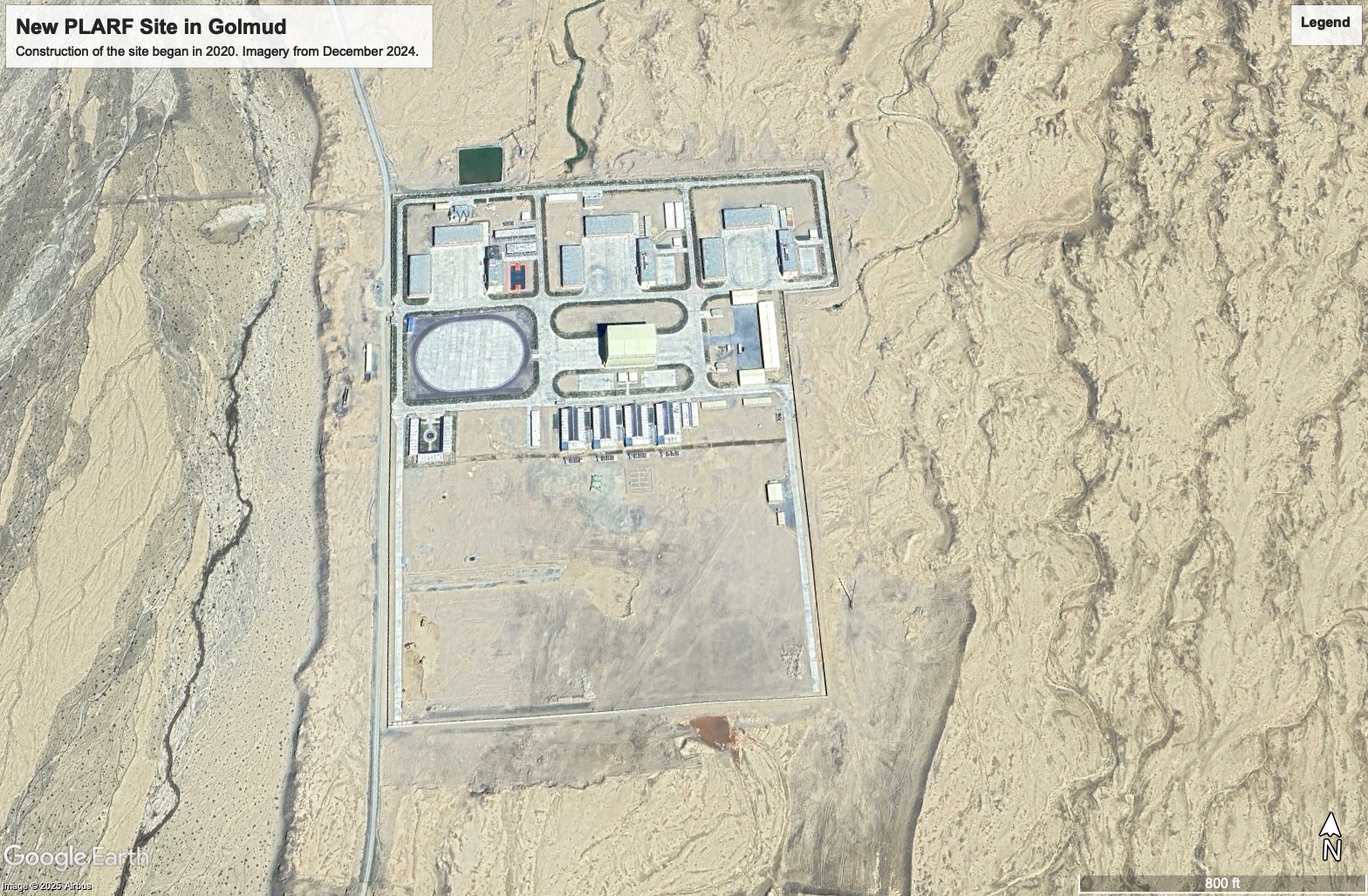
A PLARF-linked site near Golmud city. Construction of the site began in 2020. Source: Google Earth.
Recent satellite imagery reveals a central base compound at the Golmud coordinates, featuring a large high-bay garage – likely intended to house transporter-erector-launchers (TELs) – alongside several support facilities. From this main complex, a new network of roads extends deep into the surrounding desert, linking the base to multiple prepared concrete launch pads.
These launch pads follow a configuration characteristic of the PLARF’s road-mobile missile brigades, which rely on dispersed launch sites to enhance survivability and operational flexibility. By late 2024, imagery showed the addition of an inflatable, dome-shaped structure within the compound. The installation may serve as a decoy or a temporary shelter for equipment, a practice previously observed among Chinese missile units seeking to obscure activity from satellite reconnaissance.
Unit Designation and Order of Battle
The missile units near Golmud are likely subordinate to PLARF Base 64, which oversees operations in northwestern China. No new Military Unit Cover Designator (MUCD) has been publicly identified yet for the new expansion in Golmud, but available evidence suggests the formation of a new brigade rather than a restructured Second Artillery unit.
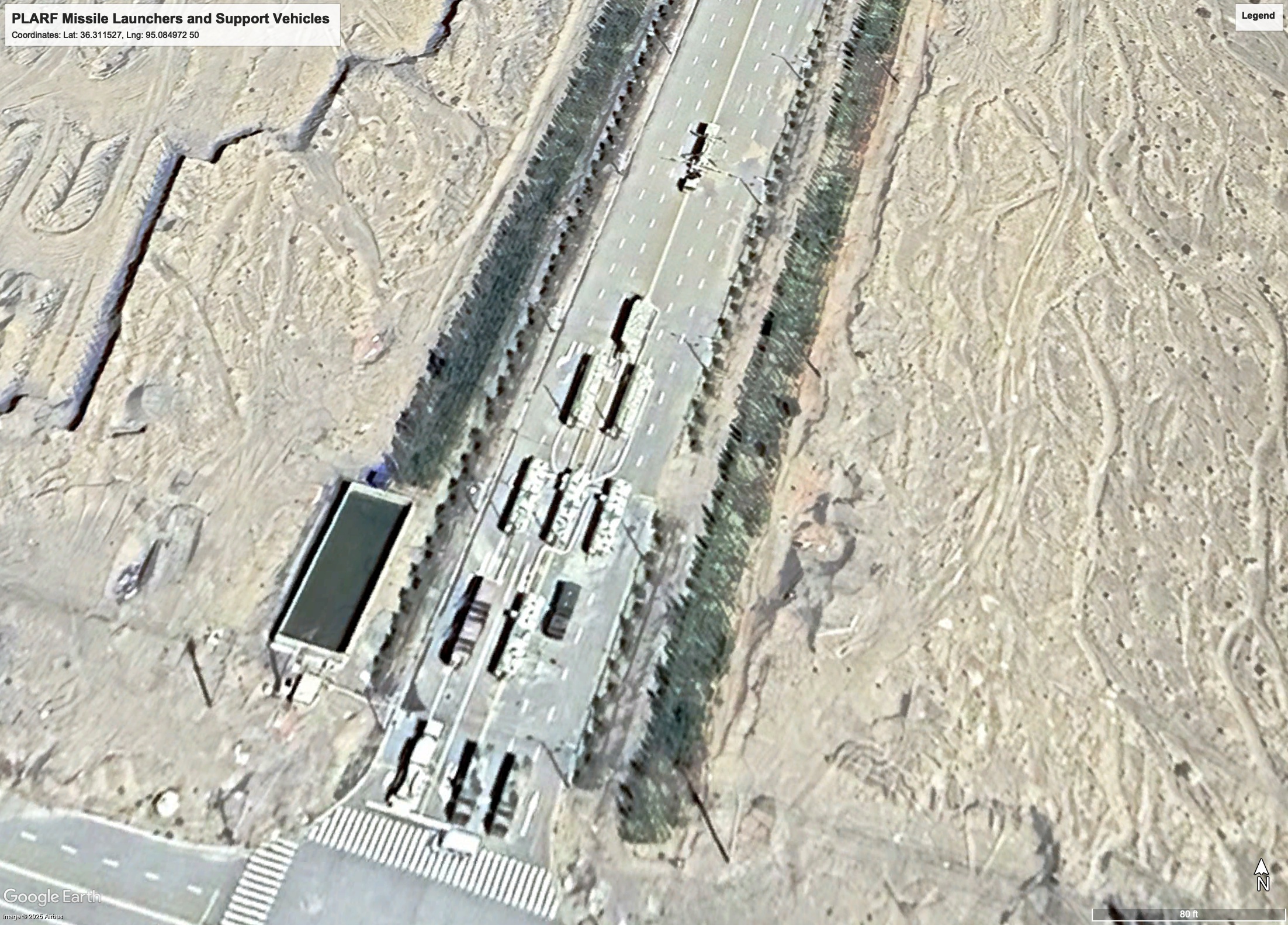
PLARF missile launchers and support vehicles seen near the Golmud site. Source: Google Earth.
Like other PLARF formations, the nearby 647th Missile Brigade – the closest known unit to the new Golmud complex – holds a division-deputy leader grade status and is typically commanded by a senior colonel. Between 2018 and 2020, its leadership reportedly included Commander Zhang Jun and Political Commissar Wang Qin. The brigade’s internal organization likely follows the standard Rocket Force brigade model, featuring multiple launch and support elements.
According to a comprehensive PLARF order of battle study, the 647th Brigade fields up to six launch battalions, alongside communications, technical, and operational support units – a larger structure than earlier Second Artillery formations. Each launch battalion operates its own transporter-erector-launcher (TEL) vehicles and support units, reflecting the PLA’s ongoing expansion of launcher numbers.
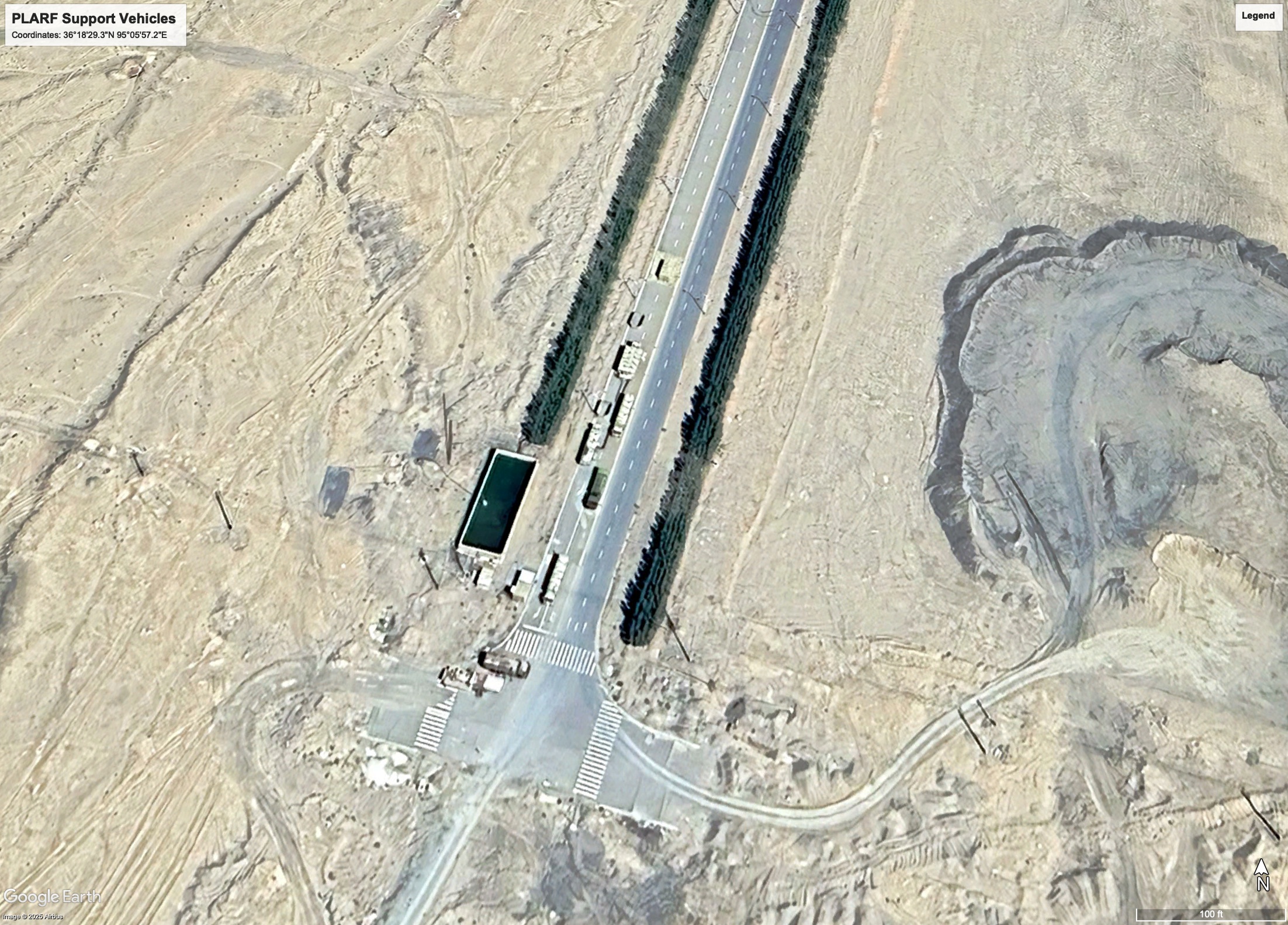
PLARF missile launchers and support vehicles seen near the Golmud site. Source: Google Earth.
While the Golmud unit remains under development, fully equipped PLARF brigades now deploy substantial launcher inventories. The U.S. Department of Defense estimated that China possessed roughly 250 DF-26 launchers in 2023, equivalent to about seven brigades with 36 TELs each. Once operational, the Golmud brigade could field a similar complement of 24–36 TELs – consistent with recent trends showing an increase in launchers per brigade as new systems are introduced.
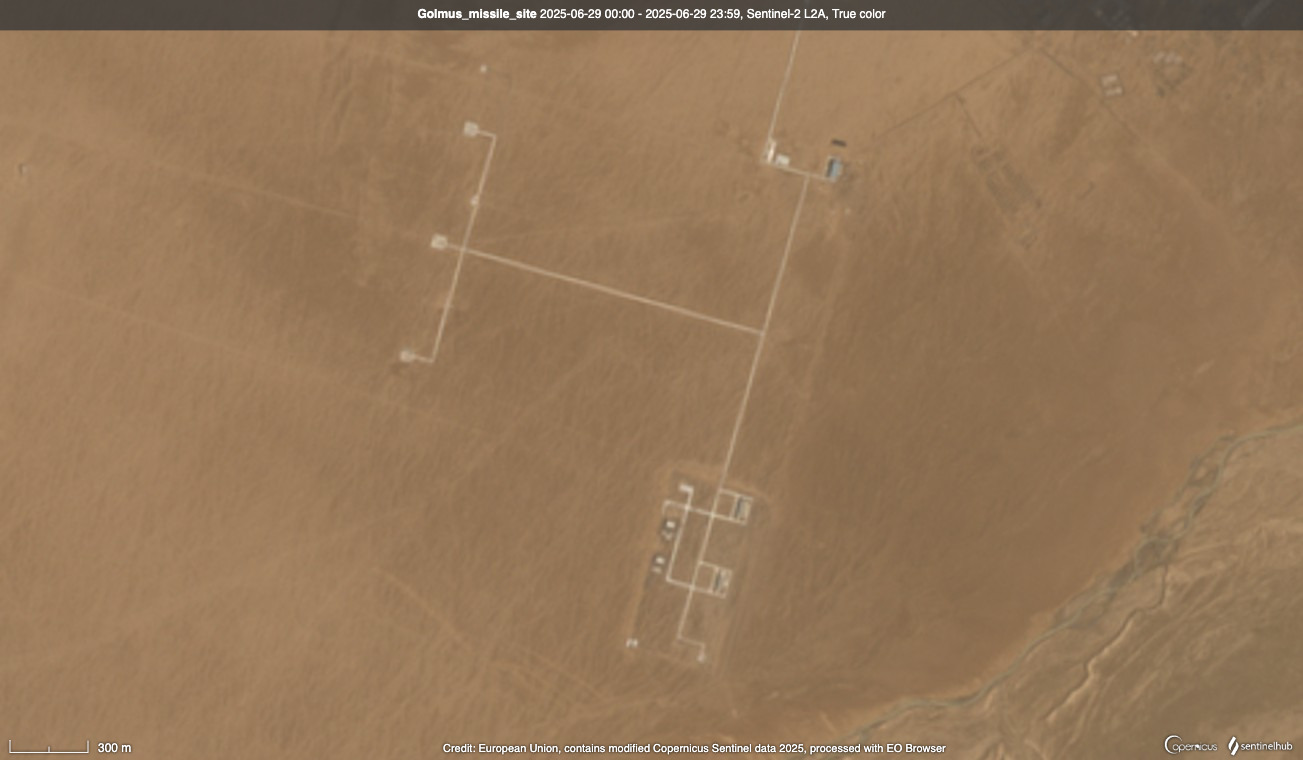
The PLARF launch/testing pad near Golmud. Source: Copernicus/Sentinel Hub.
As of late 2024, imagery showed multiple launch pad sites, but not all were active, suggesting the brigade may not yet have all launch battalions fully populated.
Notably, Chinese state media reports in 2024 hinted that the PLARF was phasing out older DF-21 MRBMs and inducting more advanced missiles in brigades across Gansu, Qinghai, etc., underscoring the expansion underway.
In October 2024, Chinese President Xi Jinping even inspected a PLARF brigade in Anhui with 25 DF-26 TELs and called for reaching full operational strength – this emphasis likely applies to Golmud’s unit as well. The new Golmud brigade can be expected to field at least a dozen TELs initially, with the number likely expanding to more than 30 launchers in the coming years.
Training Exercises and Deployments in the Golmud Region
Golmud’s high-altitude desert environment has long been used for military training, and 2024–2025 was no exception for the PLARF. Local government and media reports indicate that Rocket Force units conducted field training deployments (“驻训”) in the Golmud area, and these activities were recognized and supported by civilian authorities.
In late July 2024, on the eve of China’s Army Day on August 1, Golmud’s top officials visited troops “stationed or training in Golmud” to extend holiday greetings. The official news release by the Golmud Veterans Affairs Bureau (dated July 30, 2024) noted that multiple units were on training rotation in the area, referring to them collectively as “驻(训)部队” (units stationed in or training at Golmud).
Golmud City’s Party Secretary Zhao Dong praised these units for “actively participating in local economic construction” and urged them to “keep honing their skills and fulfilling missions,” while pledging that the local government would continue to support the troops. This indicates that during summer 2024, elements of the PLARF (among other services) were deployed around Golmud for training exercises, and their presence was significant enough to merit high-level local engagement and support (part of Golmud’s decades-long tradition as a “military city”).
Furthermore, evidence of specific PLARF training activity in 2025 can be found in the legal/propaganda domain. In May 2025, a joint military-civil “Popularize the Civil Code” outreach event was held at a Rocket Force field training site in Qinghai. According to an August 1, 2025 report by the Qinghai Provincial People’s Procuratorate, a team of prosecutors delivered law education sessions to “an Army brigade and a Rocket Force training camp’s officers and men, over a thousand in total” as part of a civil law publicity campaign.
The “Rocket Force training point” (火箭军驻训点) referenced in that article suggests that a sizeable PLARF unit was deployed for training in Qinghai’s high plateau (likely in the Qaidam/Golmud region) at that time.
Troops at this site received legal lectures and Q&A on topics like property rights and family law, indicating a long-duration training deployment where such outreach was feasible. This is consistent with the practice of PLARF units conducting live-fire drills and high-altitude training in south west China.
Chinese official media has not shown or mentioned the Golmud base (due to its sensitive nature), but there are hints of activity. Taiwan’s Ministry of National Defense did note in September 2024 that PLARF brigades in Gansu, Qinghai, etc., carried out multi-wave missile test firings as part of exercises.
In particular, on September 29, 2024, PLARF units in “Inner Mongolia, Gansu, Qinghai, and Xinjiang” simultaneously conducted missile launch drills – suggesting that the Qinghai-based unit (very possibly the one near Golmud) participated in those live-fire exercises aimed at demonstrating strategic reach. Although Chinese official outlets did not specify launch locations, the inclusion of Qinghai in those reports aligns with the presence of a missile brigade in the Golmud region.
These live-fire exercises coincided with China’s first ICBM test into the Pacific in decades. The Qinghai launches were likely done by units like the Golmud brigade, suggesting it may have participated in test-firings or exercises of its new missiles.
In summary, the 2024-2025 period saw active PLARF training and operations in the Golmud area. Local government support around exercises (with officials visiting training troops in Golmud) and special initiatives like law education at a Rocket Force field camp highlight the close civil-military cooperation. These activities, combined with evidence of missile unit drill coverage in Qinghai, confirm that Golmud continues to be a vital training and deployment area for the PLARF under Base 64.
A Strategic Game-Changer for India and the U.S.
The deployment of a DF-26 brigade to western China would have significant strategic effects. The missile’s 4,000km range means that from Qinghai, the PLARF could hit airbases and logistics hubs across India and the northern Indian Ocean. The missile’s ability to switch between nuclear and conventional warheads complicates India’s escalation calculus.
China could also redeploy DF-26 units from Golmud toward the South China Sea or Western Pacific, giving the PLARF a flexible reserve that strengthens deterrence vis-à-vis the United States and its allies. The missile is often dubbed the “Guam Express” for its ability to target U.S. bases on Guam during a Taiwan contingency. The deployment of missiles in Golmud, out of the reach of Taiwan’s long-range missile systems, provides Beijing a new set of options during a regional conflict.
Establishing another DF-26 brigade would signal that the PLARF is accelerating its transition from the older DF-21 to modern DF-26 systems. The deployment’s dual-capable ambiguity heightens escalation risks in a crisis, especially along the China-India border where conventional and nuclear signaling could easily blur.
The expansion of PLARF infrastructure near Golmud underscores China’s push to strengthen its deterrence posture in the western part of the country, with Base 64 emerging as a central hub for long-range strike capabilities. The deployment of DF-26 – and potentially DF-27 – missiles from this location enhances Beijing’s ability to pressure India, extend reach toward the U.S. Pacific presence. It signals continued force modernization after recent institutional setbacks, while simultaneously complicating regional missile defense planning and increasing escalation risks due to the dual-capable ambiguity of these systems.













